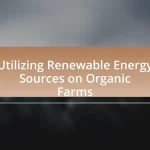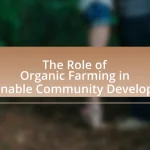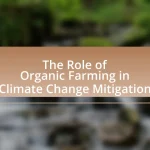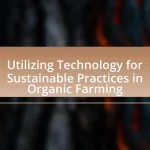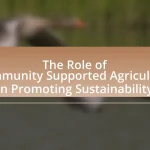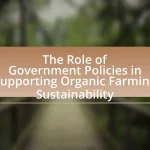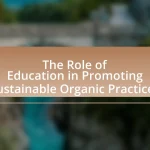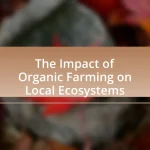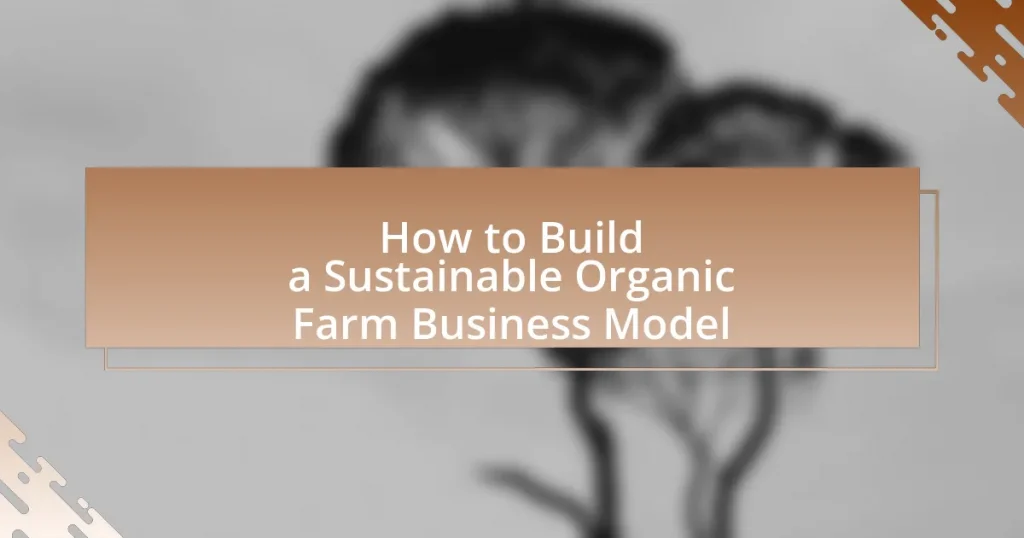A sustainable organic farm business model integrates environmentally friendly agricultural practices with economic viability and social responsibility. This model emphasizes organic farming techniques such as crop rotation, composting, and natural pest control to enhance soil health and biodiversity while minimizing chemical inputs. Key components include ecological practices, economic sustainability, social responsibility, and community engagement, all of which contribute to a resilient farming operation. The article also addresses the differences between sustainable organic and conventional farming, the importance of soil health, challenges faced by organic farms, and strategies for effective market access and financial management.
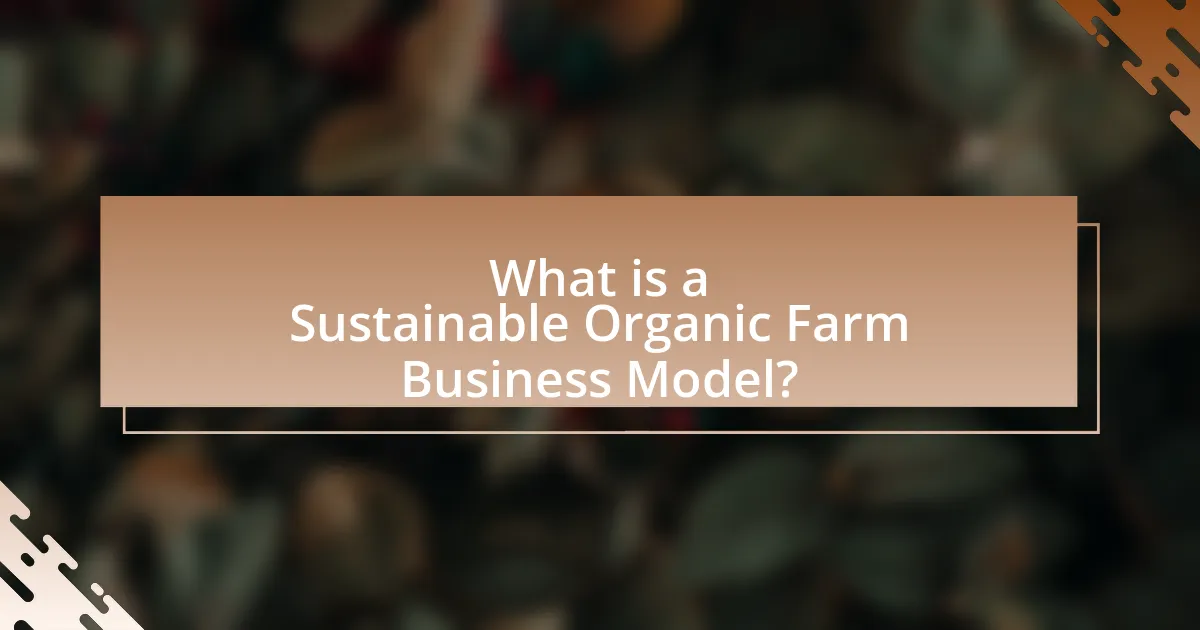
What is a Sustainable Organic Farm Business Model?
A sustainable organic farm business model is a framework that integrates environmentally friendly agricultural practices with economic viability and social responsibility. This model emphasizes the use of organic farming techniques, such as crop rotation, composting, and natural pest control, to maintain soil health and biodiversity while minimizing chemical inputs. According to the USDA, organic farming can lead to higher prices for products, which supports farmers’ income and encourages sustainable practices. Furthermore, this model often includes community engagement and education, fostering local food systems and enhancing consumer awareness about sustainable agriculture.
How does a sustainable organic farm differ from conventional farming?
A sustainable organic farm differs from conventional farming primarily in its practices and principles, focusing on ecological balance and biodiversity. Sustainable organic farms utilize natural methods for pest control, soil fertility, and crop rotation, avoiding synthetic fertilizers and pesticides, which are commonly used in conventional farming. Research indicates that organic farming can enhance soil health and reduce environmental impact, as evidenced by a study published in the journal “Agriculture, Ecosystems & Environment,” which found that organic farms had 30% higher biodiversity compared to conventional farms. This commitment to sustainability not only promotes environmental health but also supports local ecosystems and communities.
What practices define sustainable organic farming?
Sustainable organic farming is defined by practices that promote ecological balance, biodiversity, and soil health while avoiding synthetic chemicals. Key practices include crop rotation, which enhances soil fertility and disrupts pest cycles; composting, which recycles organic matter to enrich soil; and integrated pest management, which utilizes natural predators to control pests. These methods are supported by research indicating that organic farming can improve soil quality and increase biodiversity, as shown in studies published by the Rodale Institute, which found that organic systems can sequester more carbon in the soil compared to conventional methods.
Why is sustainability important in agriculture?
Sustainability is important in agriculture because it ensures the long-term viability of farming practices while minimizing environmental impact. Sustainable agriculture promotes soil health, conserves water, and reduces reliance on chemical inputs, which can lead to healthier ecosystems. For instance, practices such as crop rotation and organic farming enhance biodiversity and improve soil structure, resulting in increased resilience against pests and diseases. According to the Food and Agriculture Organization, sustainable practices can increase food security and support rural livelihoods, demonstrating their critical role in addressing global challenges like climate change and resource depletion.
What are the key components of a sustainable organic farm business model?
The key components of a sustainable organic farm business model include ecological practices, economic viability, social responsibility, and community engagement. Ecological practices involve using organic farming methods that enhance soil health, biodiversity, and ecosystem services, which are essential for long-term productivity. Economic viability ensures that the farm can generate sufficient income to sustain operations and support the livelihoods of farmers, often achieved through value-added products and direct-to-consumer sales. Social responsibility emphasizes fair labor practices and the well-being of farm workers, while community engagement fosters relationships with local consumers and organizations, promoting local food systems. These components collectively contribute to a resilient and sustainable organic farming operation, as evidenced by studies showing that farms integrating these principles often experience improved profitability and community support.
How do crop selection and diversity impact sustainability?
Crop selection and diversity significantly enhance sustainability by promoting ecosystem resilience and reducing dependency on chemical inputs. Diverse crops can improve soil health, as different plants contribute various nutrients and organic matter, fostering a balanced ecosystem. For instance, intercropping systems have been shown to increase biodiversity, which can lead to natural pest control and reduced disease prevalence, thereby minimizing the need for synthetic pesticides. Research indicates that farms with higher crop diversity can yield up to 20% more than monoculture systems, as diverse plantings can better utilize resources such as water and nutrients. This approach not only supports environmental health but also contributes to economic sustainability by providing farmers with multiple income streams and reducing risks associated with market fluctuations.
What role does soil health play in organic farming?
Soil health is crucial in organic farming as it directly influences crop productivity, nutrient availability, and ecosystem balance. Healthy soil supports a diverse microbial community that enhances nutrient cycling and improves plant health, leading to higher yields and resilience against pests and diseases. Research indicates that organic farming practices, such as crop rotation and cover cropping, significantly improve soil organic matter and microbial activity, which are essential for maintaining soil fertility and structure. For instance, a study published in the journal “Agriculture, Ecosystems & Environment” found that organic farming systems can increase soil organic carbon levels by up to 30% compared to conventional methods, demonstrating the vital role of soil health in sustainable agricultural practices.
What challenges do sustainable organic farms face?
Sustainable organic farms face several significant challenges, including higher production costs, pest management issues, and market access difficulties. Higher production costs arise from the need for organic inputs, which are often more expensive than conventional alternatives, leading to reduced profit margins. Pest management is complicated by the restrictions on synthetic pesticides, requiring farmers to adopt more labor-intensive and time-consuming methods, which can impact crop yields. Additionally, market access is often limited due to competition with larger conventional farms and the need for certification, which can be a lengthy and costly process. These challenges collectively hinder the growth and sustainability of organic farming operations.
How can market access affect the success of organic farms?
Market access significantly influences the success of organic farms by determining their ability to sell products at competitive prices and reach a broader customer base. When organic farms have strong market access, they can connect with consumers who prioritize organic products, leading to increased sales and profitability. For instance, a study by the Organic Trade Association in 2021 reported that organic food sales in the U.S. reached $61.9 billion, highlighting the growing consumer demand for organic products. Additionally, effective market access can reduce transportation costs and improve supply chain efficiency, further enhancing the financial viability of organic farms. Thus, the ability to access markets directly correlates with the economic success and sustainability of organic farming operations.
What are the financial challenges of starting an organic farm?
Starting an organic farm faces significant financial challenges, primarily due to high initial investment costs. These costs include purchasing organic seeds, equipment, and land, which can be substantially higher than conventional farming. For instance, a study by the USDA indicates that organic farming can require up to 30% more capital investment compared to traditional methods. Additionally, organic farms often experience lower yields in the initial years as soil health improves, leading to reduced income during the startup phase. Furthermore, organic certification processes can incur additional fees and require time, delaying potential revenue. These factors collectively contribute to the financial hurdles that new organic farmers must navigate.
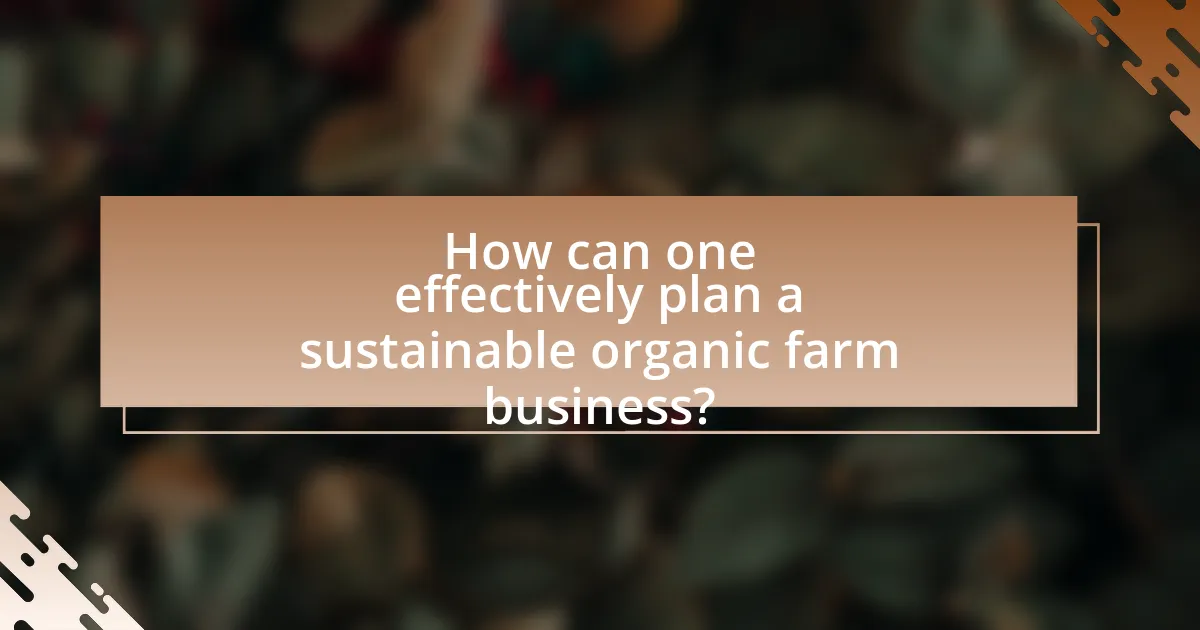
How can one effectively plan a sustainable organic farm business?
To effectively plan a sustainable organic farm business, one must conduct thorough market research to identify demand for organic products and assess competition. This foundational step ensures that the business aligns with consumer preferences and market trends, which is crucial for success. According to the USDA, the organic food market has seen consistent growth, with sales reaching $62 billion in 2020, indicating a strong consumer interest in organic products.
Next, developing a comprehensive business plan that outlines goals, production methods, financial projections, and marketing strategies is essential. This plan should incorporate sustainable practices such as crop rotation, composting, and integrated pest management to enhance soil health and reduce environmental impact. Research from the Rodale Institute shows that organic farming can increase soil organic matter by 22% over time, leading to improved crop yields and resilience.
Additionally, securing funding through grants, loans, or investors is vital for initial setup and operational costs. The USDA offers various programs to support organic farmers, which can provide financial assistance and resources.
Finally, establishing a network with local farmers, agricultural organizations, and consumers can facilitate knowledge sharing and market access, further enhancing the sustainability and profitability of the organic farm business.
What steps are involved in creating a business plan for an organic farm?
Creating a business plan for an organic farm involves several key steps. First, conduct thorough market research to understand demand, competition, and pricing in the organic farming sector. Next, define the farm’s mission and vision, which will guide its operations and goals. Following this, outline the specific products or services the farm will offer, such as vegetables, fruits, or livestock, and detail the production methods that will be used to maintain organic standards.
After defining the offerings, develop a marketing strategy that includes branding, target audience identification, and promotional tactics to reach potential customers. Financial planning is crucial; this includes estimating startup costs, ongoing expenses, and projected revenues, as well as identifying funding sources such as loans or grants. Additionally, create an operational plan that outlines daily farm management, staffing needs, and equipment requirements.
Finally, compile all these elements into a cohesive document that serves as a roadmap for the farm’s development and growth. This structured approach ensures that the business plan is comprehensive and actionable, increasing the likelihood of success in the organic farming industry.
How do you conduct market research for organic products?
To conduct market research for organic products, start by identifying target demographics and their preferences regarding organic goods. Utilize surveys and focus groups to gather qualitative data on consumer attitudes and buying behaviors. Analyze existing market reports and studies, such as those from the Organic Trade Association, which indicate that organic food sales reached $62 billion in 2020, reflecting a growing consumer interest. Additionally, monitor competitors and their product offerings to identify market gaps and opportunities. This structured approach ensures a comprehensive understanding of the organic market landscape.
What financial projections should be included in the business plan?
A business plan for a sustainable organic farm should include financial projections such as sales forecasts, expense budgets, cash flow statements, profit and loss statements, and break-even analysis. Sales forecasts estimate future revenue based on market research and historical data, while expense budgets outline expected costs associated with operations, including labor, materials, and overhead. Cash flow statements track the inflow and outflow of cash, ensuring the farm can meet its financial obligations. Profit and loss statements summarize revenues and expenses to determine net income over a specific period. Finally, break-even analysis identifies the sales volume needed to cover costs, providing insight into the viability of the business model. These projections are essential for assessing financial health and attracting potential investors or lenders.
How can sustainable practices be integrated into the business model?
Sustainable practices can be integrated into the business model by adopting methods such as organic farming, resource conservation, and community engagement. Organic farming reduces chemical inputs, promoting soil health and biodiversity, which can lead to higher yields and better market prices. Resource conservation techniques, such as water management and renewable energy use, lower operational costs and enhance resilience against climate change. Community engagement fosters local partnerships and consumer loyalty, which can increase sales and support for sustainable initiatives. According to the USDA, organic farming can yield 20% more profit per acre compared to conventional methods, demonstrating the financial viability of integrating sustainability into business models.
What are the benefits of crop rotation and cover cropping?
Crop rotation and cover cropping enhance soil health and agricultural sustainability. Crop rotation prevents soil nutrient depletion by alternating different crops, which can reduce pest and disease cycles, leading to higher yields. Cover cropping, on the other hand, improves soil structure, reduces erosion, and enhances organic matter content, which contributes to better water retention and nutrient availability. Research indicates that farms employing these practices can see a 10-20% increase in crop yields and a significant reduction in the need for chemical fertilizers and pesticides, promoting a more sustainable farming model.
How can water management practices enhance sustainability?
Water management practices enhance sustainability by optimizing the use of water resources, reducing waste, and improving crop yields. Efficient irrigation techniques, such as drip irrigation, minimize water loss and ensure that plants receive the necessary moisture without excess runoff. According to the Food and Agriculture Organization, implementing efficient irrigation can reduce water use by up to 50% while maintaining or increasing agricultural productivity. Additionally, practices like rainwater harvesting and soil moisture monitoring contribute to sustainable water use, allowing farms to adapt to changing climate conditions and ensuring long-term viability. These methods not only conserve water but also promote healthier ecosystems by maintaining groundwater levels and reducing soil erosion.
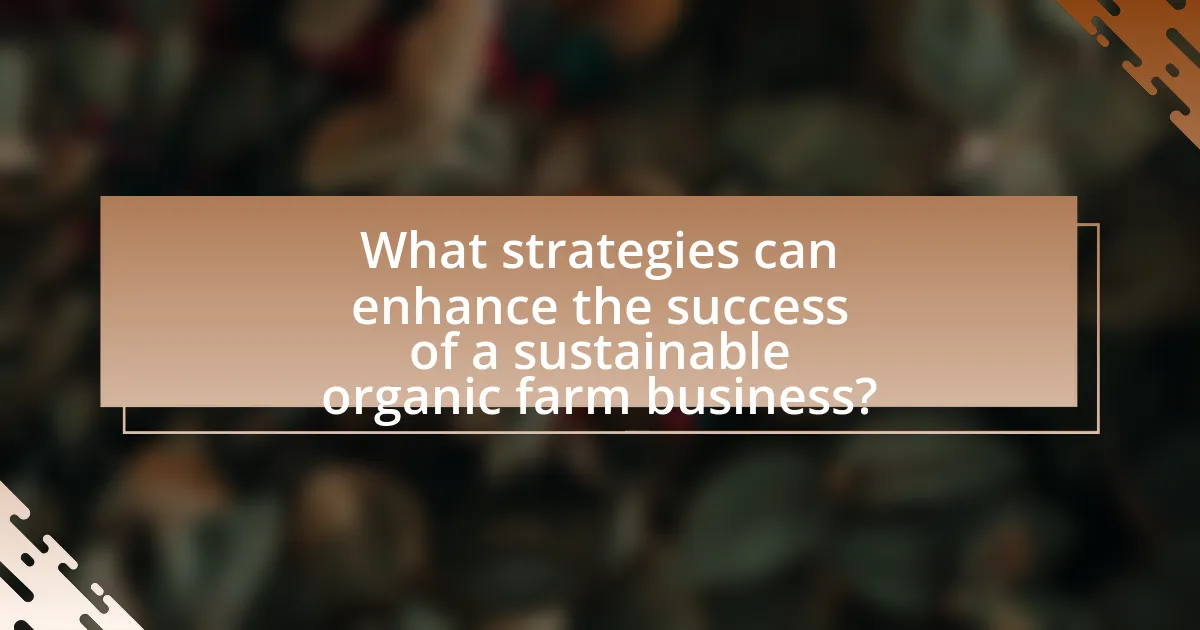
What strategies can enhance the success of a sustainable organic farm business?
Implementing crop rotation, diversifying crops, and utilizing integrated pest management are key strategies that can enhance the success of a sustainable organic farm business. Crop rotation improves soil health and reduces pest and disease pressure, leading to higher yields. Diversifying crops can mitigate risks associated with market fluctuations and environmental changes, as different crops may thrive under varying conditions. Integrated pest management minimizes reliance on chemical pesticides by using biological controls and cultural practices, which can lead to healthier ecosystems and reduced costs. According to a study published in the Journal of Sustainable Agriculture, farms employing these strategies reported a 20% increase in overall productivity and profitability over five years.
How can marketing strategies be tailored for organic products?
Marketing strategies for organic products can be tailored by emphasizing their health benefits, environmental sustainability, and ethical sourcing. Organic products often attract consumers who prioritize health and wellness, so highlighting certifications like USDA Organic can enhance credibility. Additionally, storytelling about the farming practices and the positive impact on the environment can resonate with eco-conscious consumers. Research indicates that 76% of consumers are willing to pay more for sustainable products, demonstrating the market potential for organic offerings. Engaging with customers through social media and community events can also foster loyalty and brand awareness, as these platforms allow for direct interaction and education about the benefits of organic farming.
What role do community-supported agriculture (CSA) programs play?
Community-supported agriculture (CSA) programs play a crucial role in connecting consumers directly with local farmers, thereby fostering a sustainable food system. These programs allow consumers to purchase shares of a farm’s harvest in advance, providing farmers with upfront capital to cover production costs and ensuring a stable income. According to a study published in the Journal of Agriculture, Food Systems, and Community Development, CSA programs can increase farm viability by reducing financial risk and enhancing community engagement. This model not only supports local economies but also promotes the consumption of fresh, seasonal produce, contributing to healthier diets and environmental sustainability.
How can social media be utilized to promote organic farming?
Social media can be utilized to promote organic farming by creating engaging content that highlights the benefits of organic practices, shares success stories, and connects with consumers directly. Platforms like Instagram and Facebook allow farmers to showcase their products, share educational posts about organic farming methods, and engage with a community interested in sustainable agriculture. For instance, a study by the Journal of Agricultural and Environmental Ethics found that social media campaigns can significantly increase consumer awareness and preference for organic products, demonstrating its effectiveness in reaching a broader audience.
What are the best practices for maintaining profitability in an organic farm?
To maintain profitability in an organic farm, farmers should implement diversified crop rotations, optimize resource management, and engage in direct marketing strategies. Diversified crop rotations enhance soil health and reduce pest pressures, leading to higher yields and lower input costs. For instance, a study by the Rodale Institute found that diverse cropping systems can increase yields by up to 30% compared to monocultures. Optimizing resource management, such as utilizing cover crops and efficient irrigation techniques, can significantly reduce expenses and improve sustainability. Additionally, engaging in direct marketing, such as farmers’ markets or community-supported agriculture (CSA), allows farmers to capture higher prices for their products, increasing overall profitability. Research indicates that farms utilizing direct-to-consumer sales can earn up to 50% more than those relying solely on wholesale markets.
How can value-added products increase revenue streams?
Value-added products can increase revenue streams by transforming raw agricultural goods into higher-value items that appeal to consumers. For example, turning fresh fruits into jams or juices allows farmers to charge a premium price compared to selling the raw produce. According to the USDA, value-added agriculture can enhance profitability by diversifying product offerings and tapping into niche markets, which can lead to increased sales and customer loyalty. This strategy not only boosts revenue but also helps stabilize income by reducing reliance on commodity prices.
What financial management techniques are essential for sustainability?
Essential financial management techniques for sustainability include budgeting, cost control, and financial forecasting. Budgeting allows organic farm businesses to allocate resources effectively, ensuring that funds are directed towards sustainable practices. Cost control helps in minimizing waste and optimizing resource use, which is crucial for maintaining profitability while adhering to sustainable principles. Financial forecasting enables farmers to anticipate future financial conditions, allowing for informed decision-making that aligns with sustainability goals. These techniques collectively support the long-term viability of organic farming by promoting efficient resource management and strategic planning.
What common pitfalls should be avoided in organic farming?
Common pitfalls to avoid in organic farming include inadequate soil management, neglecting pest control, and failing to understand market demands. Inadequate soil management can lead to nutrient depletion and reduced crop yields, as organic farming relies heavily on healthy soil for productivity. Neglecting pest control can result in infestations that compromise crop health, as organic methods require proactive strategies to manage pests without synthetic chemicals. Additionally, failing to understand market demands can lead to overproduction or misaligned crop choices, ultimately affecting profitability. Research indicates that successful organic farmers prioritize soil health, integrated pest management, and market research to sustain their operations effectively.
How can over-reliance on a single crop be detrimental?
Over-reliance on a single crop can be detrimental because it increases vulnerability to pests, diseases, and market fluctuations. When a farm focuses solely on one crop, such as corn, it risks total crop failure if that crop faces a pest outbreak or disease, as evidenced by the 2012 U.S. corn drought that severely impacted yields. Additionally, market dependence on a single crop can lead to economic instability; for instance, if prices drop due to oversupply or changes in consumer demand, farmers may face significant financial losses. Diversifying crops can mitigate these risks, promoting resilience and sustainability in farming practices.
What mistakes do new organic farmers often make?
New organic farmers often make the mistake of underestimating the importance of soil health. Soil health is crucial for sustainable farming, as it directly affects crop yield and resilience against pests and diseases. Many new farmers neglect soil testing and fail to implement proper crop rotation and cover cropping practices, which can lead to nutrient depletion and increased vulnerability to soil erosion. Research indicates that healthy soil can increase crop productivity by up to 20%, highlighting the necessity of prioritizing soil management in organic farming.
What practical tips can help in building a sustainable organic farm business model?
To build a sustainable organic farm business model, implement crop rotation to enhance soil health and reduce pest issues. Crop rotation involves alternating the types of crops grown in a specific area to improve soil fertility and disrupt pest cycles, which can lead to higher yields and reduced reliance on chemical inputs. Research indicates that farms practicing crop rotation can increase their productivity by up to 20% compared to monoculture systems. Additionally, integrating agroecological practices, such as cover cropping and composting, can further enhance soil quality and biodiversity, contributing to long-term sustainability.
